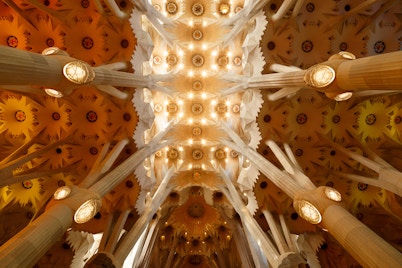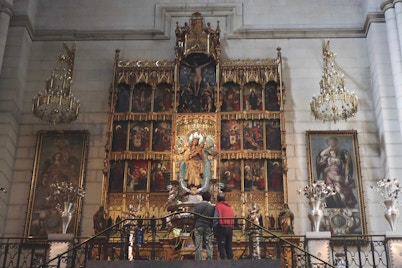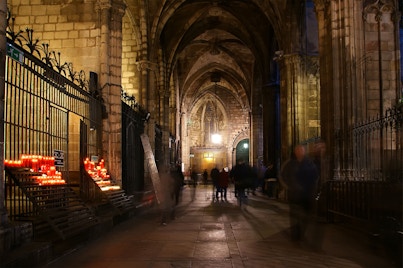- Sagrada Familia
- Sagrada Familia Towers
- Crypt
- Gaudi
- History
- Architecture
- Design
- Inside
- Nativity Facade
- Facades
- Glory Facade
- Mass
- Finish Date
- Dress Code
- Passion Facade
- Christmas
- Park Güell
- Barcelona Flamenco Show Tickets
- Camp Nou Tours
- Casa Batllo
- Casa Mila
- The World of Banksy Barcelona
- Portaventura World
- Casa Vicens
- Hola Barcelona Travel Card
- Wax Museum Barcelona
- Las Golondrinas Barcelona
- Palau De La Musica Catalana
- Erotic Museum of Barcelona
- Montserrat Monastery
- Barcelona Zoo
- KBr Photography Center Mapfre Foundation
- Big Fun Museum
Take A Close Look At What's Inside Gaudi's Sagrada Familia
Top things to see inside Sagrada Familia
The meticulous blending of Christian iconography into Gaudi's distinctive design makes Sagrada Familia a structure, unlike anything you have ever seen. While people often focus on the exteriors of this spectacular structure, there’s a lot to be seen on the inside of the Sagrada Familia basilica. The colorful stained glass panes set against the delicate carvings, the high columns, and the crypt, all speak volumes about the complexity of this structure.

High Columns
As you walk through the cathedral, you will be struck by the sheer enormity of construction. Gaudi has been known to use nature as a muse, and the massive columns within the cathedral have been built to resemble trees growing in a forest, leaving you with the illusion of walking through a botanical garden rather than a site of religious worship.

Stained Glass Windows
The stained glass windows adorning the walls are magnificent, but what will leave you awe-struck is the way Gaudí envisioned the structure. The colors on each glass have been chosen based on the time of day the sun would shine through the window, filling the room with blues and reds to represent the birth and suffering of Christ.

The Apse
The apse, a semi-circular structure with a dome, is generally part of a cathedral in which the altar lies. Gaudi ensured the apse of the Basilica felt light and open and designed it in a way that natural light from the outdoors would spill into it. The apse houses seven chapels, dedicated to the seven sorrows of joys of Saint Joseph.

The Altar
At the center of the apse and directly above the crypt is the altar, whose ceiling is higher than the rest of the apse to accentuate its divinity. Keeping with tradition, above the altar is a canopy, also known as the Baldachin.
It has a heptagon shape, with seven edges, which represents the seven gifts of the Holy Spirit. Fifty hanging lights illuminate its rim of the canopy, and you will find grape vines and wheat that are the symbols of the Eucharist,springing from the rims. You will also find the Prayer of Glory written on a ribbon attached around the baldachin.

The Eternal Father
While Gaudi was the main architect of the Basilica, upon his passing, the project was continued by those who shared his vision. Of these was an architect, Jordi Bonet, who was responsible for creating the Eternal Father.
Clearly visible from the Gloria entrance, the Eternal Father is a triangular symbol located in the large hyperboloid just above the presbytery, which houses the priests.The golden triangle, framed by the hyperboloid, symbolizes the Eternal Father.

The Door of Glory
The bronze Door of Glory was designed by the controversial sculptor Josep Maria Subirachs. A part of the unfinished Glory Façade, the Door of Glory has the Lord’s prayer inscribed on it in more than 50 different languages. The Lord’s Prayer was arranged random and in a work of coincidence, the handle of the door also has the letters “A” and “G”, referring to the initials of Antoni Gaudi, inscribed on it.
The Glory Façade, once completed, will operate as the main entrance into the Basilica.

The Sagrada Familia Crypt
The crypt, which houses Gaudí’s tomb, is a chapel where the masses are celebrated regularly. It is located under the apse and can be accessed by a staircase. The crypt is surmounted by a large vault that is adorned with an image of the Annunciation to Mary.
There are four chapels inside the Sagrada Familia, each with its own unique dedicatee: The Virgin of Carmel, where Gaudí is buried; Jesus Christ; the Virgin of Montserrat; and Crucified Christ, which houses Josep María Bocabella's tomb. The floor of the crypt is decorated with a Roman mosaic, representing ears of wheat and vines.The crypt is protected by UNESCO as a World Heritage site.
Explore the Crypt
Organ
Construction of the Basilica, as with that of most churches, would be incomplete without an instrument. In this case, the organ would be supported by 8,000 pipes, to be able to listen to the acoustics from every cranny of the Basilica.
The organ is currently a work in progress but is being constructed in a way that would allow each instrument to be played individually, as well as in harmony. The Basilica is truly paving the way for an unmatched religious experience.

Sagrada Familia Museum
On display are models, charts, and designs depicting Gaudi’s plans for construction. While a lot of his original designs were burnt or destroyed during the Spanish Civil War, the plans that were pieced together or salvaged are now open for public viewing.
While all the carvings on the walls of the Basilica were once done by hand, today the help of computers and machines have been enlisted to aid in its construction. Visitors are welcome to watch as the architects work on completing what is unfinished of Gaudi’s cathedral.
Book Tickets to Sagrada Familia
Frequently asked questions about what’s inside Sagrada Familia
From its stained glass windows, chapels, and altars, to its towers dedicated to the Apostles, the Sagrada Familia Basilica is an architectural marvel, depicting the life of Jesus Christ.
Yes, you can tour inside the Sagrada Familia after purchasing tickets. You can opt for guided tours or audio guides in various languages to make the most of your visit. A tour of the Basilica would take 3-4 hours of your day.
You need a ticket to enter Sagrada Familia. The type of ticket you purchase would depend on the areas you would like to see, as different tickets are available with different inclusions. You can purchase the Sagrada Familia tickets online.
The carvings, the crypt housing Gaudi’s tomb, the stained glass windows, the Baldachin, and the nature columns, are all must-see highlights inside the Sagrada Familia.
A. Yes, visitors are allowed to enter inside Sagrada Familia. Two of the three Façades are complete and now open to the public. On purchasing a ticket, one can enter the Sagrada Familia Basilica.
The Basilica is 4,500 sq. m. with the capacity to house 14,000 visitors at once. On completion, the tower dedicated to Christ would stand at 172.5m, making the Basilica the tallest church in the world, surpassing Germany’s Ulm Minster.
Construction of the Basilica commenced in 1882, following the design of architect Francisco de Paula del Villar. In 1883, Gaudí took over the project and worked on it till his death in 1926.
The three entrances of the Sagrada Familia symbolise the three virtues of Love, Hope and Faith. The columns are constructed to symbolise the saints rising into heaven and the angels descending to meet them. The different colours on the stained glass windows symbolise the birth of Christ, resurrection, water and light.
The columns inside the Sagrada Familia take on the hue of blue, red, green, yellow and ochre thanks to the stained glass windows.
Commercial photography is not permitted inside the Basilica. Special permission is required to enter with professional photography equipment. However, you are free to take pictures with camera phones.
No, you need to purchase tickets to go inside Sagrada Familia. Tickets to enter the Basilica start at 17 euros per person, and can go up to 33 euros a person, depending on the inclusions. A basic ticket would not include access to the towers.
As a functioning Catholic church, Visitors are expected to dress modestly while visiting the Sagrada Familia. To enter inside the basilica, you must be wearing clothes that cover your shoulders and reach below the mid-thighs. Hats, swimwear and costumes with promotional content or offensive/distracting designs are not allowed.
The exteriors of the Basilica are a sight in itself, but the interiors tell a whole different story. You will be left in awe at the intricate carvings, the play on lights and colours, and the magnitude of thought that went into designing the Basilica.
The Sagrada Familia opening hours are 9 AM to 6 PM everyday, however closing time can extend to 8 pm between April and September. Timings may differ on holy days of the year including Christmas.
Mass is held at the Basilica every Sunday at 9 AM. Entry for mass is free, but seating capacity is limited. The mass lasts close to an hour and is conducted in several languages.



